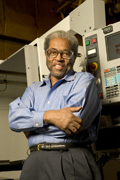Machine Shop supervisor Charles Matthews retires
 |
| Charles Matthews |
Charles Matthews' influence appears in the speed of circling protons, the glisten of modern art and the diversity of Fermilab's workforce.
He retired last month after 38 years at the laboratory, including 20 as machine shop supervisor.
Fermilab's first director, Robert Wilson, discovered Matthews' creative streak when he enlisted his help to cut and finish metal for the 32-foot tall Obelisk sculpture in the reflecting pond and a table sculpture in the second-floor crossover, as well as Matthews's repairs on the Mobius strip sculpture.
Matthews's craftsmanship also shines in components of the accelerator rings.
"He was really instrumental in the construction of the cryostats for the Tevatron, so he's one of those unsung heroes of the Tevatron that own a piece of the top quark discovery," said Paul Mantsch, former Technical Division head.
"Every day was something interesting and there was always closeness with the engineers and designers," Matthews said.
He quickly moved up the ranks, bringing that team attitude with him. He and his shop managers routinely thanked staff members and solicited their opinions for improving safety.
Under his guidance, the shop modernized and specialized in difficult jobs. He also changed the face of the shop by recruiting women, members of ethnic minorities and young people and, along with Mantsch, reviving the Fermilab apprenticeship program
"That was rewarding," he said.
To promote careers in metal working, he gave talks at area high schools and judged a machinery competition among the Fox Valley schools.
Matthews also made a name for himself with a stellar safety record in a dangerous environment.
"He used every opportunity available to him to lobby upper management for better facilities and better equipment to make the shop as safe as possible for his workers," said Bill Griffing, head of ES&H.
-- Tona Kunz
|